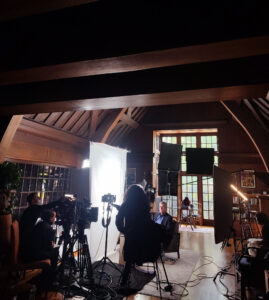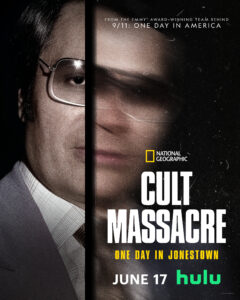On 17 June, a three-part documentary series on the Jonestown tragedy premiered on Hulu. Cult Massacre: One Day in Jonestown produced by 72 Films, an independent documentary company in London, UK, will also air on National Geographic on 14 August.
The series was 18 months in the making. From the beginning of our work in January 2023, we at 72 Films were conscious that whilst some documentaries of the tragedy of 18 November 1978 have been thoughtful and thought-provoking, many more have been simplistic retellings in which a complex social and cultural history had been boiled down to references to Kool-Aid and suicide.
We intended to make a documentary that precisely followed the archival footage that was filmed when Congressman Ryan visited Jonestown. We wanted to go on an immersive journey, into the unknown following in the footsteps of a group of journalists, congressional staff and concerned families, all of whom had different reasons for traveling together to Guyana while learning about the utopia and dream that Jonestown was built on, as well as the nightmare that followed.
The Archive
Perhaps unsurprisingly as filmmakers, when we work on a film about the past, we have a particular interest in the visual footage from the time that might help tell our story.
Over multiple days including 18 November 1978, a small NBC crew accompanied Congressman Leo Ryan on his investigation to Jonestown, Guyana. NBC cameraman Bob Brown travelled into Jonestown with the Congressman and filmed much of the visit. Even though Brown was killed during the attack on the Ryan party at the Port Kaituma airstrip – as his camera was rolling – this footage survived. Immediately, we knew we wanted to use this remarkable archive to build a thorough account of the events that unfolded over the weekend of Congressman Ryan’s visit to Jonestown.
This unique footage became the spine of our series, and we spent months working hard to ensure that we got hold of every surviving frame. We would then use interviews and archive of Peoples Temple to give context around the events that happened.
We combed through the footage, identifying who appeared in frame by working with experts and relatives, and comparing with photos and videos of Peoples Temple. Via this research process we identified key eyewitnesses to the story – people we would go on to interview.
The Research
Once we had this footage, we wanted to understand exactly what we were seeing. This involved researching as much as possible, using books and films, FBI records and newspaper articles documenting the history of Peoples Temple and the Jonestown settlement in Guyana. We also had a team of specialist archivists who got in touch with a great many private and public libraries and collections, to unearth as much archive film footage and photography of the Peoples Temple as they could find.
The Jonestown Institute quickly became a key resource for all information on the history of Jonestown. Though we had all researched historical topics before in our work, never had we come across such an encyclopaedic source of information. We felt very lucky that such a comprehensive and rich resource on this topic had been made accessible to the public.
Shortly, we were in touch with the Institute’s managers, Fielding and Rebecca. We cannot express enough how grateful we are for their generous support throughout this project. Their unmatched knowledge, sensibility and guidance was critical in informing how we should approach this sensitive topic, and our engagement with the rest of the community.
As we learned more about the story, it became clear to us that Jonestown was fundamentally an American story: it was a lens through which we could glimpse the culturally tumultuous era of 1970s America. Racism and inequality remained rife into the 1970s, veterans were returning to the US after the Vietnam War to mixed receptions, the bucolic ideals of the 60s counterculture had failed, and many were finding the world to be a dark and hostile place. All these social factors became fuel for disheartened citizens to place their trust in Jim Jones’ and his promises of a fairer society. We were keen to highlight these points in our series and understand who and why people joined the Temple, as well as asking the wider question of ‘how could this happen?’
The People
Our preliminary research into Peoples Temple provided a useful factual foundation, but in order to better understand what happened, we needed to speak to those who were some way directly involved and could speak with personal nuance and sincerity about the topic.
This, however, made us dependent on the kindness and willingness of the surviving Temple community, many of whom understandably still carry deep and painful memories around the events of 18 November, to speak to us. With the help of the Institute, we began to reach out to former Temple members, survivors and loved ones in order to gain as wide and as deep an understanding of this history as we could.
We were overcome by how forthcoming people were in sharing their stories with us. Many conversations we had involved discussing painful memories, but we were struck by the abundance of joyful, familial memories people had of their time in Peoples Temple and in Jonestown. In every case, there was colour and vibrancy in their testimony, and we knew we were incredibly lucky to be learning about this through the memories of the community directly.

We had the opportunity to fly to the USA and meet many former Temple members, speaking candidly face to face. We visited the Jonestown memorial in Oakland. We realised that this absolutely was a ‘community’, tight-knit and that Peoples Temple may have been fronted by Jim Jones, but that it was the many committed members who were determined in their mission to build a special, empowering community for all. We felt that it was crucial for us to be able to portray this side of Peoples Temple too – the extraordinary people and their visionary ambition. Despite what Jonestown became, it was striking that most people we spoke to about their experiences in Peoples Temple mentioned the church included some of the very best people they had ever known.
Often, historical documentaries would employ the use of a narrator (an actor with a script who introduces the story and moves it along) or ‘talking heads’ (specialists who may have written extensively on the topic to help set scenes and offer context). But given the personal nature of the Jonestown story, we knew no one understood or could tell this story more accurately than those who had been immediately or intimately connected to the events of 18 November 1978. We decided that this documentary would use the voices of the people who experienced it first-hand only; a testimony of survivors.
We had the privilege of filming with several individuals who had once been a part of Peoples Temple, some of the Concerned Relatives, Jonestown defectors, members of the delegation who had accompanied Congressman Ryan on his fateful trip to Jonestown, and some Americans who were involved in the aftermath of the tragic events of 18 November.
We’re so thankful for the Peoples Temple community welcoming us and speaking to us about their stories. Whether we had research conversations, cups of coffee, broke bread, or sat down for interview with people, all the information provided us have been pivotal in helping us understand the timeline of events as well as the complicated mosaic of experiences connected to this important history.
Despite this tragedy having occurred 45 years ago, the legacy of Jonestown is still very much alive. We were struck by the sense of compassion and community that remains among the survivors and families.
Our hope is that this series of three 44-minute films can be an historical document about the Jonestown tragedy, delivered in a manner that is empathetic to the community, and the many who tragically lost their lives that day.
One Day in Franchise
This series represents the third installment of the Emmy® Award-winning, critically acclaimed franchise One Day In America. For 72 Films, David Glover and Mark Raphael are executive producers, and Marian Mohamed is series director, along with Academy Award® winning filmmakers Dan Lindsay and T.J. Martin. For National Geographic, Carolyn Payne is executive producer, and Tom McDonald is executive vice president of Global Factual and Unscripted Content.
[Note: A trailer for the series appears here.]
